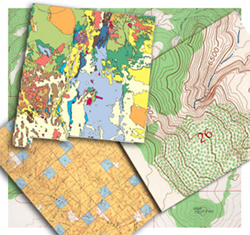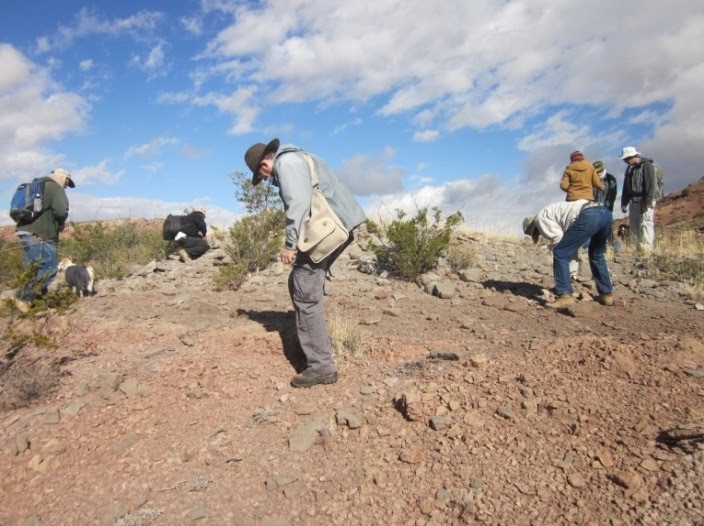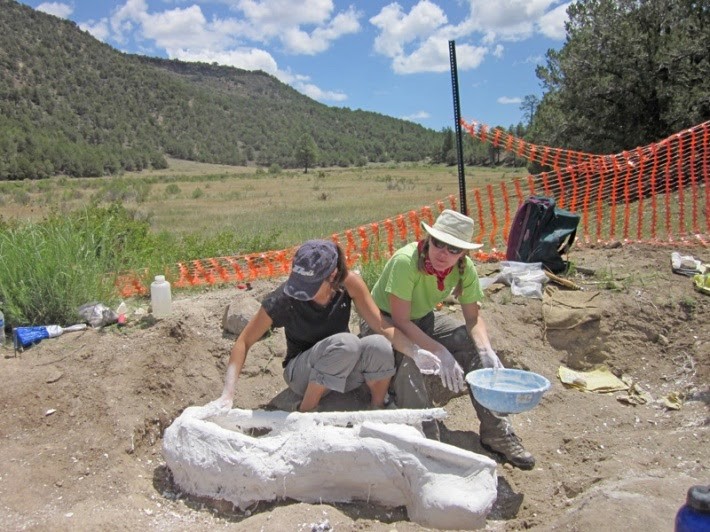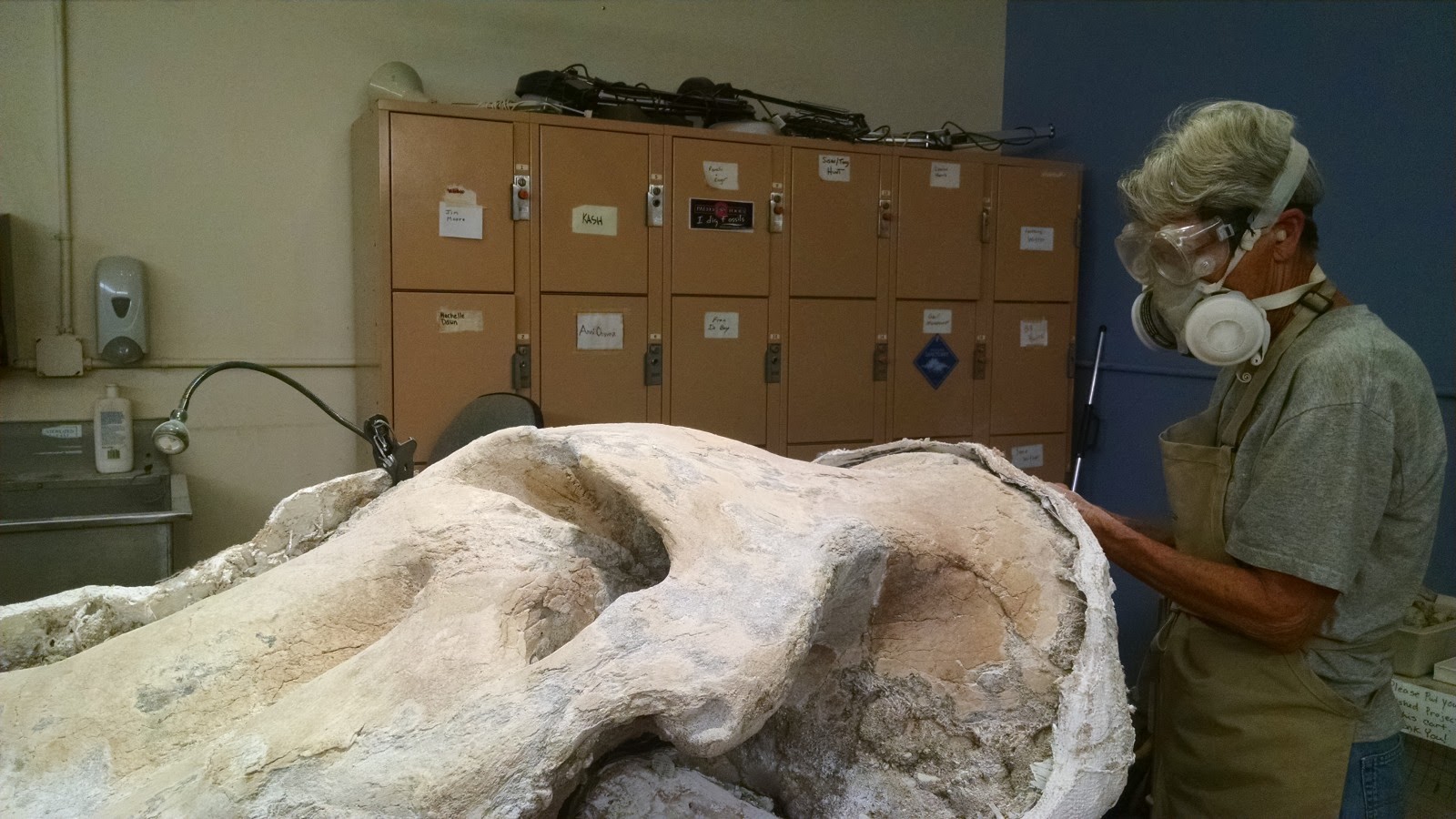The Museum is currently closed for rennovations. Updates on the renovation will be available through the link Renovation Updates as well as through the museum's social media.
You are here
Collecting Fossils
Collecting a Fossil: the Process
A paleontologist is a scientist that studies fossils, however, there are many different ways to contribute to the study of fossils. There is so much work to be done, most paleontologists specialize in a certain task. In general, paleontologists concentrate on one of four overlapping specializations, which work together to expand our scientific knowledge: research, fieldwork, preparation and collections. The process of interpreting the data a specimen has to offer moves a fossil through each of these specializations in step, sometimes more than once.
To skip to a particular section, click the links below:
Research

Researchers (generally curators at museums or professors at universities) study fossils with the intent to publish peer reviewed scientific papers. This aspect of paleontology usually requires an advanced degree, such as a Masters or PhD in geology or (increasingly) biology. Before any of our curators leave the museum, they must do extensive research about what and where they want to collect fossils. This includes reading books, bulletins and journal articles and consulting maps. The journals that are consulted are specialized scientific journals such as the Journal of Vertebrate Paleontology, Journal of Paleontology, or Science. Reading these journals provides curators with up to date information about recent discoveries from their colleagues around the world.
Bulletins and institutional publications are also used for research. Bulletins are made up of a series of papers from various authors on a single subject or can be in-depth study that would be too long to put in a journal article. The NMMNH has published over 80 bulletins since 1992.
Maps are among the most important sources a paleontologist consults before going out into the field. The types of maps are: Land status maps, Geologic maps and Topographic maps. The various types of maps each provide distinct information:

Land Status Maps: These maps outline who controls a particular piece of land, whether it's the State of New Mexico, the Bureau of Land Management (BLM), the Military, a Native American tribe, or a private land owner. Paleontologists must have a permit or permission from the land owner in order to collect fossils.
Geologic Maps: These maps show paleontologists where rocks of certain ages are exposed; this helps them decide where they go to look for fossils of a certain age.
Topographic Maps: These maps provide a picture of what the actual land looks like; from these maps hills, mountains, arroyos, and plains can all be discerned. Often paleontologists will take copies of these maps into the field in order to orient themselves and note where fossils have come from.
Field Work
Once research has been completed, and the paleontologist knows where they want to go, field work begins. There are some paleontologists that specialize in field work, but most of the time, field crews are made up of researchers and their students, preparators, and volunteers. Field work is divided into two parts: Prospecting and Quarrying.

Prospecting is done by walking a section of specific age rock while looking for fossils. Prospecting leads to a list of promising localities (or sites) to return to where fossils have been found for possible, or prospective, quarrying.
Quarrying itself is the act of removing material (in this case the fossil) from the ground where it was found. There are three categories of quarry sites: Microsites, Single Excavation Sites, and Quarries.

Microsites: yield fossils that are typically 2cm or less and need to be put under a high powered microscope to be examined. The process used to recover these microfossils is called screenwashing. It consists of running bags of fossil rich debris through various sizes of screen with water and then picking the fossils out under a microscope.
Single excavation sites: are one time excavations with a limited amount of bone, usually a single bone or a single group of associated fossils. Most techniques used for quarrying are for single excavations.
Quarrying: a type of excavation where the amount of bones at a site is extensive and requires multiple plaster jackets in order to remove. Quarries can be worked for many years or even decades before they stop producing fossils.
When a fossil is found, a trench is dug around it, marking its presumed edges. Plaster soaked bandages are draped over the specimen, surrounding material and all, for transport to a lab where work to preserve the fossil can be done in a controlled environment. We call these plaster coverings jackets. The fossil is then lugged back any way it can be. Sometimes, these jackets are so heavy, they need to be extracted from their location by helicopter!
Preparation

Once a specimen has been transported to the lab, preparation of the specimen can begin. Preparation is the process of clearing fossils of the material they are encased in (referred to generally as matrix) and getting them ready for research or display. Preparators are highly trained professionals that specialize in techniques for removing matrix and fixing broken fossils. You can see this process first hand at the FossilWorks exhibit on the first floor of the New Mexico Museum of Natural History and Science. First, the jacket must be sawed open to reveal the surface of the specimen and a plan of attack formed. The techniques used depend on the material, but usually involve using small tools, like dental picks and chisels, to slowly remove the matrix and reveal the fossil. This process can take years depending on the size and condition of the specimen. Since the matrix is usually the only thing keeping the fossil from falling apart, as it is removed, the fossil becomes more susceptible to erosion and breaking, so preparators add materials, like consolidants (glues), that penetrate the bone and stabilize it from most breaks.
Displaying
Fossils have been displayed many ways over the decades. While these displays were historically made by preparators, using heavy, original bone, it is much more common today for museums to have a team of in house exhibit artists that work hand in hand with paleontologists to do this. These days, many fossils on display at most museums are casts of original specimens that are stored in the institution's collection or even held at institutions in other parts of the world. The process involves making a mold of a fossil, usually made of silicone resin. From this mold, a cast is made, usually out of polyester resin (the same plastic many toys are made of). Since the cast is a copy, it is not as huge a loss if it is damaged and it is a fraction of the weight of the actual fossil, making it both easier and safer to display. These casts are painted to match the original specimen, which can make them exceedingly difficult to tell apart from the original.
Collections
 Any fossils that are not displayed for the public to see (90-99% of museum fossils are not on display) are stored in the museum’s collections, a repository for housing scientific specimens for study. Datasets describing these collections are curated by collections staff and used worldwide for research. The New Mexico Museum of Natural History and Science’s Paleontology Collection houses over 80,000 of these catalogued items. Collections are vital to the scientific process by safeguarding the specimens used to name and describe a species (called “type specimens”) and making the specimens readily available for scientists and others to study and compare. They also make reproducing results and subsequent experimentation possible, a cornerstone of science. Museum collections are used for education, research, and exhibits. The collections are maintained by a collections manager, who is a scientist usually trained in paleontology, geology and/or museum studies, that is sometimes likened to a librarian, who helps people find specimens and the information associated with them.
Any fossils that are not displayed for the public to see (90-99% of museum fossils are not on display) are stored in the museum’s collections, a repository for housing scientific specimens for study. Datasets describing these collections are curated by collections staff and used worldwide for research. The New Mexico Museum of Natural History and Science’s Paleontology Collection houses over 80,000 of these catalogued items. Collections are vital to the scientific process by safeguarding the specimens used to name and describe a species (called “type specimens”) and making the specimens readily available for scientists and others to study and compare. They also make reproducing results and subsequent experimentation possible, a cornerstone of science. Museum collections are used for education, research, and exhibits. The collections are maintained by a collections manager, who is a scientist usually trained in paleontology, geology and/or museum studies, that is sometimes likened to a librarian, who helps people find specimens and the information associated with them.



